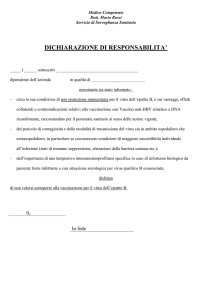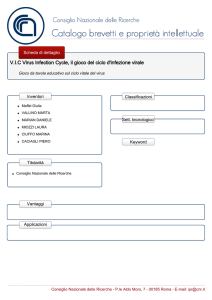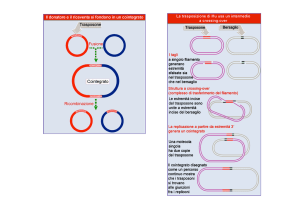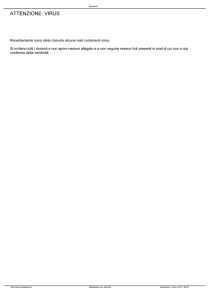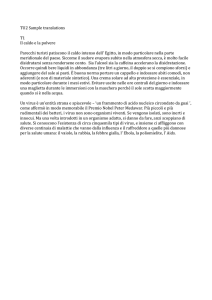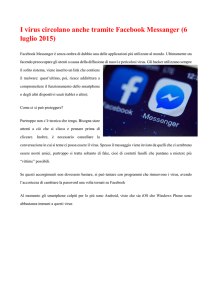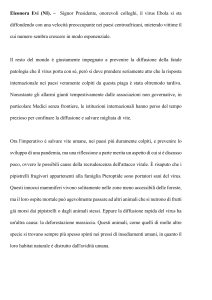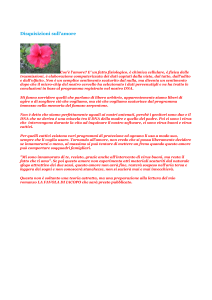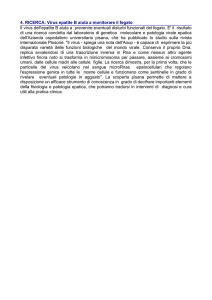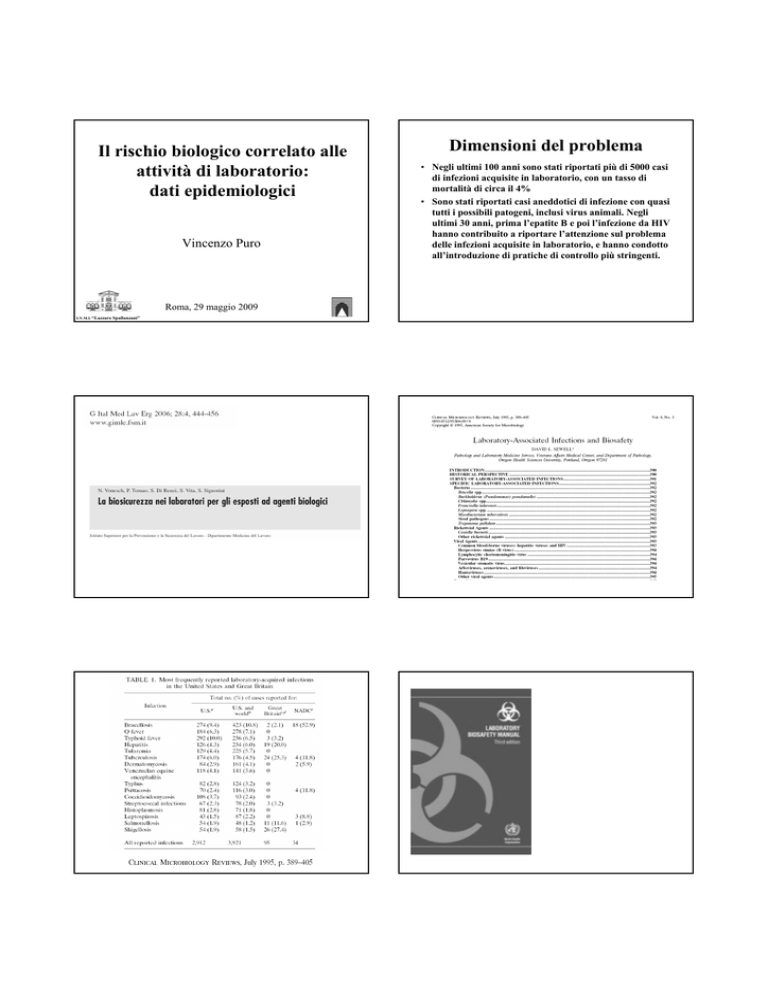
Il rischio biologico correlato alle
attività di laboratorio:
dati epidemiologici
Vincenzo Puro
Roma, 29 maggio 2009
I.N.M.I. “Lazzaro Spallanzani”
Dimensioni del problema
• Negli ultimi 100 anni sono stati riportati più di 5000 casi
di infezioni acquisite in laboratorio, con un tasso di
mortalità di circa il 4%
• Sono stati riportati casi aneddotici di infezione con quasi
tutti i possibili patogeni, inclusi virus animali. Negli
ultimi 30 anni, prima l’epatite B e poi l’infezione da HIV
hanno contribuito a riportare l’attenzione sul problema
delle infezioni acquisite in laboratorio, e hanno condotto
all’introduzione di pratiche di controllo più stringenti.
I 10 principali rischi biologici emergenti individuati nell’indagine.
A school is at the centre of Britain's largest swine flu outbreak
after 44 new cases were confirmed there, taking countrywide
total to 184
Eurosurveillance, Volume 14, Issue 21, 28 May 2009
Cluster of new influenza A(H1N1) cases in travellers returning
from Scotland to Greece – community transmission within the
European Union?
Greece reported two new confirmed cases which most likely
acquired the infection in Edinburgh, UK. Both of them are
students attending the same university in the UK and were
close contacts. The first case developed symptoms in the UK,
the second one after his return to Greece. This is the first
detection of confirmed cases in EU/EFTA countries with
probable exposure in another EU/EFTA country.
CDC - Interim Biosafety Guidance for All Individuals
Working with Clinical Specimens or Isolates from Patients
with Suspected Novel Influenza A (H1N1) Virus Infection
CDC - Interim Biosafety Guidance for All Individuals
Working with Clinical Specimens or Isolates from
Patients with Suspected Novel Influenza A (H1N1) Virus
Infection
Viral isolation
Clinical Laboratory Testing (Laboratory Diagnostic Work)
Diagnostic laboratory work on clinical samples from patients who are suspected cases of novel
influenza A (H1N1) virus infection should be conducted in a BSL2 laboratory. All sample
manipulations with the potential for creating an aerosol should be done inside a biosafety
cabinet (BSC) that is certified annually. Personal protective equipment should include.
·
Gloves
·
Laboratory coat
·
Eye protection
Growth of virus in cell culture or embryonated eggs from human clinical specimens that
are suspected cases of novel influenza A (H1N1) virus infection should be performed in
a BSL2 laboratory with BSL3 practices.
·
·
·
·
·
All viral manipulations should be done inside a BSC that is certified annually.
Personal protective equipment may include the following based on a site specific risk
assessment:
Respiratory protection – fit-tested N95 respirator or higher level of protection.
Shoe covers
Closed-front gown
Double gloves
Eye protection
Diffusione del virus e ospiti
Tabella 1. OMS. Periodo e fasi pandemiche.
Periodo pandemico
Periodo
Fasi pandemiche
Epidemiologia
Fasi
nell’uomo
Fase 1
Periodo
interpandemi
co
Nessuna infezione
umana
Fase 2
Epidemiologia nell’uomo
Basso rischio di infezione
nell’uomo
Alto rischio di infezione
nell’uomo
Assenza o rari casi di
Fase 3
Periodo di
allerta
pandemica
Infezioni umane
Fase 4
sporadiche
trasmissione interumana
Trasmissione interumana in
aumento
Fase 5
Periodo
Infezioni umane
pandemico
comuni
Fase 6
Significativa trasmissione
interumana
Trasmissione interumana
efficiente e sostenuta
Fase 5 caratterizzata dall'interessamento di grandi "cluster" o gruppi, ma con diffusione
interumana ancora localizzata, che indicano che il virus migliora il suo adattamento
all'uomo, ma non e' ancora pienamente trasmissibile (concreto rischio pandemico)
H10 N4
429 casi, 262 decessi
UK
2007
4 cases
EID June 2009
SARS
Summary of probable SARS cases with onset of illness
from 1 November 2002 to 31 July 2003
Totale
Letalità
Letalità
8098
9.6 %
Op. sanitari
(%)
1707
(21)
WHO 26 Sept 2003
China, March-April 2004
SARS cases after July 2003
Cina
• 1 businessman
• 1 waitress
• 1 TV journalist
• 1 Hospital Director
National Institute of Virology
Beijing
Singapore
1 lab worker
Lab PG Student
Mother
(Death)
Taiwan
1 lab worker
Lab Researcher
Caring Nurse
Father
Mother
Aunt
Patient
(hospitalized in the same room)
Daughter-in-law
(visitor)
Restaurant exposure!
No secondary cases
International response to the distribution of a H2N2 influenza virus for laboratory testing: Risk
considered low for laboratory workers and the public 12 April 2005
The Public Health Agency of Canada (PHAC) informed WHO on 26 March that an influenza A/H2N2 virus was identified
by a local laboratory in Canada. The H2N2 virus identified was found to be similar to H2N2 viruses that circulated in
humans in 1957-58 at the beginning of the so-called Asian influenza pandemic. The H2N2 virus which circulated at this time
was fully transmissible among humans. It continued to circulate in humans and cause annual epidemics until 1968, when it
vanished after the emergence of influenza A/H3N2 viruses that caused the next pandemic. Therefore, persons born after 1968
are expected to have no or only limited immunity to H2N2. H2N2 virus is not contained in current trivalent influenza
vaccines.
Update: International response to the inadvertent distribution of H2N2 influenza virus: Destruction of
virus panels proceeding 15 April 2005
Since WHO announced on 12 April that an influenza A/H2N2 was inadvertently distributed to 3747 laboratories in 18
countries worldwide an international effort has been underway to ensure the destruction of these virus panels.
The College of American Pathologists (CAP), a private company in the USA, has used the H2N2 strain in their proficiency
testing panels since October 2004.
Update: International response to the inadvertent distribution of H2N2 influenza virus 21 April 2005
As of 21 April, national authorities in the following countries/areas confirmed to WHO that laboratories in their territories
had destroyed or secured the proficiency panels containing H2N2 virus. The destruction of H2N2 virus panels is ongoing and
is expected to be completed shortly.
Laboratories with workers with relatively recent exposure (within the last
10 days) to the H2N2 test samples monitor their worker’s health for
influenza-like-illness: temperature of greater than or equal to 100
degrees F and cough or sore throat).
If a laboratory worker with recent exposure to the H2N2 samples
develops such symptoms, clinical specimens should be obtained and
tested for influenza A.
Commercially available rapid test kits for influenza and other methods for
rapid detection of influenza virus, such as indirect fluorescent antibody
assay, direct fluorescent antibody assay, and polymerase chain reaction
should be used.
Lab workers exposed to H5N1 in Czech Republic,
Slovenia and Germany - February 2009
Cross-Contamination of Clinical Specimens with Bacillus
anthracis During a Laboratory Proficiency Test --- Idaho,
2006
An “experimental virus material" based on human H3N2 viruses was
sent to several lab for testing on ferrets.
Ferrets at a laboratory in the Czech Republic died after being
inoculated with the H3N2 material. The material was found to
contain H5N1 and was likely contaminated during packaging in
Austria.
None of the 36 people who were exposed to the contaminated
product became infected, including 13 employees, who had
been exposed to the highly pathogenic virus for a week.
On July 18, 2006, the Utah Department of Health notified epidemiologists at the Idaho
Department of Health and Welfare that Bacillus anthracis, the causative agent for anthrax, had
been isolated from a patient.
On the same day, the Idaho epidemiologists were notified by the Idaho Bureau of Laboratories
of a specimen from a second patient received for anthrax testing.
The specimens were taken from
- a dog-bite wound on the face of a male health-care worker aged 36 years in southern Idaho
- a post-injury wound in the hand of a sculptor aged 45 years living in northern Idaho
MMWR September 12, 2008 / 57(36);993-995
Cross-Contamination of Clinical Specimens with Bacillus
anthracis During a Laboratory Proficiency Test --- Idaho,
2006
The two reports resulted briefly in alerts to the Federal Bureau of Investigation (FBI) and
precautionary treatment of one of the patients for anthrax.
An epidemiological investigation conducted by CDC started
Cross-Contamination of Clinical Specimens with Bacillus
anthracis During a Laboratory Proficiency Test --- Idaho,
2006
Epidemiological investigation:
-Neither patient had signs or symptoms consistent with B. anthracis infection.
-The Idaho hospital laboratories that tested the two specimens had been conducting the
laboratory proficiency testing exercise on samples containing the Sterne strain of B. anthracis;
-Subsequent laboratory testing of the two patient isolates detected the Sterne strain
Proficiency testing is intended to improve the ability of a sentinel laboratory to either rule out
the presence of potential category A agents or refer the isolates to the state laboratory for
confirmation.
The two specimens had become
cross-contaminated with B.
anthracis in the laboratories.
MMWR September 12, 2008 / 57(36);993-995
Cross-Contamination of Clinical Specimens with Bacillus
anthracis During a Laboratory Proficiency Test --- Idaho,
2006
Proficiency testing is intended to improve the ability of a sentinel laboratory to either rule out
the presence of potential category A agents or refer the isolates to the state laboratory for
confirmation.
MMWR September 12, 2008 / 57(36);993-995
MMWR September 12, 2008 / 57(36);993-995
Chikungunya fever outbreak currently
ongoing in India: impressive number
France
Eurosurveillance 2006
United Kingdom
Mavalankar D et al. Lancet Infect Dis 2007; 7: 306-307
Eurosurveillance 2006
MMWR 29 9 2006
Ahmedabad, India,
Emerging Infectious Diseases • Vol. 14, No. 3, March 2008
Chikungunya fever: emerging issues
Is Chik Fev a life-threatening disease?
• In La Reunion observed deaths exceeded expected deaths
during the period when Chik Fev outbreak stroke strongly the
island (Dec 2005-Apr 2006) (Josseran L et al. EID 2006; 12 (12): 1994-1995)
Occupational transmission of Chikungunya in HCW
• An autochthonous case was reported in
metropolitan France in March 2006. A nurse
developed chikungunya fever (laboratory
confirmed) three days after caring for a patient
with an imported infection. Euro Surveill 2006;11(4):
• At least 39 reported cases of laboratory
acquired infections.
http://www.phac-aspc.gc.ca/msds-ftss/msds172e.html
An outbreak of autochthonous chikungunya fever in the province of Ravenna, Italy
Two cases of autochthonous
Plasmodium falciparum malaria in
Germany with evidence for local
transmission by indigenous
Anopheles plumbeus.
Trop Med Int Health. 2001;6:983-5.
Tarantola A. et al. EID 2004;10:1848-90
A case of autochthonous Plasmodium vivax malaria, Corsica,
August 2006
A Armengaud et al
Euro Surveill 2006;11(11):E061116.3.
West Nile virus
negli USA dal 1999 ad oggi 13300 casi, 517 morti
Culex
Occupational lab acquired
West Nile virus infection
• 2 cases through percutaneous injuries
MMWR 2002;51:1133–6.
• European distribution of West Nile virus, based on the virus
isolation from mosquitoes or vertebrates, including humans
(black dots), laboratory-confirmed human or equine cases of
West Nile fever (black squares), and presence of antibodies
in vertebrates (circles and hatched areas).
• 1case after conjunctival exposure.
Emerg Infect Dis. 2005 Oct;11(10):1648-9
Italia 1998
Nella tarda estate 1998 sono stati segnalati in
Toscana, nel comprensorio denominato Padule
di Fucecchio, che interessa quattro province
(Pistoia, Lucca, Firenze, Pisa) alcuni casi
sindrome nervosa negli equini.
I numeri:
8 scuderie
1 ippodromo (Montecatini)
14 casi
6 decessi
NON SI VERIFICÒ ALCUN
CASO DI
MALATTIA NELL'UOMO.
2 casi, BSL 3, puntura accidentale, tessuto necroscopico animali
1 caso nel 2001, non descritto
WEST NILE VIRUS - ITALY
After Chikungunya cases last year [2007] now comes meningoencephalitis
in Emilia-Romagna
16 Sep 2008
• Six confirmed and five suspected cases of West Nile virus infection in
horses have been reported in the vicinity of Ferrara in Italy.
• One suspected human case (Imola)
Diagnosis confirmed at ISS and INMI Spallanzani
Oct 2008
Diagnosis of West Nile meningoencephalitis in a man living in Ferrara
This is the 2nd [human] case within a few days
Dengue
European Network on Imported Infectious Disease Surveillance:
1,117 cases in European travellers since 1999
Italia: a rischio di introduzione. Il primo ed unico focolaio è toscano (Padule di Fucecchio), nel 1998, con 14 casi clinici in
cavalli. Finora mai segnalati casi umani, ma sono state documentate positività anticorpali
Imported VHFs in Europe 1994-2004
19 cases including 11 deaths
Ebola Outbreaks
Ivory Coast
Sudan
Gabon
Uganda
DRC
(formerly Zaire)
0
2,000
4,000
South Africa
kilometers
Euro Surveillance monthly 2005; 10 (6): 102-106
• Jul 11, 2008 (CIDRAP News) – A Dutch woman
who fell ill with Marburg hemorrhagic fever after
visiting a bat-infested cave in Uganda has died.
• The case started to show symptoms of fever and
chills on 2 July after return to the Netherlands; she
was not symptomatic on the flight home. She
rapidly deteriorated on 7 July with severe
haemorrhaging.
• (Feb 3, 2009 (CIDRAP News) A case of the often
deadly Marburg hemorrhagic fever was
retrospectively identified in an American who fell ill
after a trip to Uganda in January 2008 and recovered
• The patient had visited the bat-infested "python
cave" in western Uganda
Marburg haemorrhagic fever in Angola
- Ottobre 2004-Luglio 2005:
374 casi confermati di cui 329
deceduti (letalità 88%)
- Tra i decessi 16 infermieri e due
medici, (compresa la pediatra
italiana Maria Bonino della ONG di
Padova Cuamm Doctors with
Africa).
Casi importati di febbre di Lassa
10/3/2005
ansa - NOVE PERSONE ISOLATE IN ITALIA ALLO SPALLANZANI
PER IL VIRUS MARBURGO
GINEVRA - Sono in isolamento e sotto osservazione all'Istituto
specializzato per le malattie infettive Spallanzani di Roma le 9
persone entrate in contatto in Angola con il virus di Marburg, ha
affermato a Ginevra una portavoce della Organizzazione mondiale
della sanita' (Oms).
Secondo quanto si e' appreso da fonti sanitarie dell'Istituto sono in
osservazione e in isolamento, ma le loro condizioni non destano
preoccupazione e presto saranno dimesse dall'ospedale. Si e' trattato
dunque, come ha annunciato questa mattina anche un portavoce
dell'Oms, di una misura precauzionale.
L'Oms non e' in grado di affermare se vi sia un legame tra il decesso
della pediatra e l'isolamento delle nove persone.
Table of Imported Confirmed Lassa
Fever Cases in UK Since 1970
Year of importation
Imported from
Case occupation
1971
1971
1975
1976
1981
1982
1984
1985
2000
2003
Sierra Leone
Sierra Leone
Nigeria
Nigeria
Nigeria
Nigeria
Sierra Leone
Sierra Leone
Sierra Leone
Sierra Leone
Nurse
Physician
Physician
Engineer
Teacher
Diplomat
Geologist
Nurse
Peacekeeper
Peacekeeper
2009 (1)
Nigeria
(Visiting family)
2009 (2)
Mali
(working in rural area)
Ergonul O. Lancet Infect Dis 2006; 6: 203–14
ECDC
sheet
Tuesday 8 August 2006
Crimean-Congo hemorrhagic fever – information for
travellers to north-eastern Turkey
Between 1 January and 4 August 2006, a total of 242
laboratory confirmed cases and 20 deaths
Lancet Infectious Diseases Apr 2006
A case of Crimean-Congo haemorrhagic fever i
n Greece,June2008
Eurosurveillance, Volume 13, Issue 17, 24 April 2008
PROBABLE CASES OF CRIMEAN-CONGO-HAEMORRHAGIC FEVER IN BULGARIA:
A PRELIMINARY REPORT
A Kunchev , M Kojouharova
Between 20 March and 10 April 2008, six probable Crimean-Congo-haemorrhagic
fever (CCHF) cases (1 occupationally acquired in HCW) were reported in the
municipality of Gotse Delchev, in Blagoevgrad district, Bulgaria, an area bordering
Greece and Macedonia.
CCHF is an endemic infection in Bulgaria, and particularly in this area.
In recent years, several cases of CCHF have been reported
(between two and 20 cases annually),
with a mortality rate varying between 10 and 50 percent.
Case description
A 46-year-old woman with disseminated
intravascular coagulation (DIC) died in a
hospital in Alexandroupoli, in north-eastern
Greece, in the end of June 2008. The woman
was admitted to the hospital four days earlier,
with fever, malaise, myalgia, chills and
abdominal pain. One day before death, her
condition deteriorated rapidly and she
developed heavy hemorrhage from the genital
tract, DIC and multi-organ failure.
The patient reported a tick bite four days
before admission, and that she had tried to
remove the tick herself. No travel abroad was
reported. She was engaged in agricultural
activities in a rural area near the town of
Komotini, in Rhodope prefecture, south of the
Greek-Bulgarian border (see Figure).
EUROSURVEILLANCE Vol . 13 · Issues 7–9 · Jul–Sep 2008
In 2004, a virologist at USAMRIID was working in a BSL-4 laboratory with mice infected
with a mouse-adapted variant of the Zaire Ebola virus
While the person was injectingthe fifth mouse with a hypodermic syringe that had
been used on previous mice, the needle pierced the person’s left-hand gloves, ……..
Incidenti di laboratorio e casi di infezione con FEV
12 Mar 2009
Fort Detrik Maryland, USA Feb 2004 Laboratorio di ricerca BSL-4 per la produzione di
vaccino contro Ebola: 1 esposto per ferita, non infetto
Russia
1988 1 decesso da virus Marburg
An member of the Hamburg Tropical Institute while working in
the high security laboratory received a stick injury despite wearing
3 layers of protective gloves with a needle used to inject a strain of
the Ebola haemorrhagic virus into lab mice.
The woman did not leave the University hospital and was
immediately transferred to an isolation unit.
1990 1 decesso da virus Marburg
2004 1 decesso da virus Ebola
Hamburg - Germany
2009 1 esposto per ferita, non infetto - Germania
14 Mar 2009
The patient and her doctor opted for a new type of living vaccine
that has never been tested in humans but has been shown in
monkeys to help fight the virus even when given after exposure
(Science, 14 Nov 2003, p. 1141)
2 Apr 2009 (22 d from the exposure)
The researcher who may have been exposed to the deadly
ebolavirus was declared healthy and released from isolation
The vaccine is based on vesicular stomatitis virus (VSV) whose glycoprotein has been
replaced with that of an ebolavirus.
Doctors said they would now study her immune response for evidence of
ARCA Biopharma, Colorado, rushed to Hamburg a supply of an
experimental anticoagulant drug called rNAPc2, which studies
have also shown to have promise against ebolavirus.
whether she actually contracted the virus, and whether the vaccine
helped her defeat it.
MMWRw April 18, 2008 / 57(15);401-404
Laboratory-Acquired Vaccinia Exposures and Infections --United States, 2005--2007
314 casi
214 decessi
6 HCW
XDR - TB
Migliori GB, Ortmann J, Girardi E, Besozzi G, Lange C, Cirillo DM, et al.
Extensively drug-resistant
tuberculosis, Italy and Germany
Emerg Infect Dis 2007 May
• 2,888 culture-positive TB cases analyzed
(Italy 2,140, Germany 748)
• 126 (4.4%) were MDR (Italy 83, Germany
43)
• 11 (0.4%) were XDR (Italy 8, Germany 3).
Centrifugazione
Micobatterio Tubercolare in laboratorio
Incidenza 3-9 volte maggiore che nella popolazione generale
L’operatore deve indossare:
- Doppio paio di guanti;
- Mascherina di protezione facciale;
- Occhiali o visiera (a protezione delle mucose congiuntivali).
44% dei casi di infezioni batteriche occupazionali in lab
Caricamento centrifuga
Disporre le provette nella centrifuga e chiudere il coperchio di protezione;
Trasmissione per aerosols e per puntura/tagli
se le centrifughe dotate di cestelli removibili a chiusura singola tale operazione và eseguita sotto
cappa a flusso laminare;
Apertura del coperchio
Classificato come BSL 3
• Rimuovere i coperchi di protezione sotto cappa; se non si è dotati di cestelli removibili prima di
procedere con l’apertura attendere 10 min per permettere agli aereosol di depositarsi
•Verificare l’integrità delle provette e l’eventuale spandimento di materiale biologico,
in tal caso decontaminare
Micobatterio Tubercolare in laboratorio
ESAME DIRETTO CAMPIONE RESPIRATORIO
Sottocappa
Trattare il campione con un volume uguale di ipoclorito 5% per 15
minuti
Centrifugare in centrifuga con coperchio a vite o bucketts chiudibili
ermeticamente
Sul banco
Trattamento con mucolitico e concentrazione
Colorazione
Micobatterio Tubercolare in laboratorio
Nella pratica la manipolazione del campione e
della coltura avviene sottocappa.
Il materiale fissato contiene ancora bacilli viventi
La colorazione dei campioni per l’esame diretto
per la ricerca di AAR avviene sul banco e lo
spostamento dalla cappa al banco rappresenta
una fase a possibile rischio di esposizione ad
aerosol o contaminazione da rottura del supporto.
JOURNAL OF CLINICAL MICROBIOLOGY, Mar. 2006, p. 1197–1201
Method for Inactivating and Fixing Unstained Smear
Preparations of Mycobacterium tuberculosis for
Improved Laboratory Safety.
J Clin Microbiol 2002 Nov;40(11):4077-80
Chedore P, Th'ng C, Nolan DH, Churchwell GM, Sieffert DE, Hale YM, Jamieson F.
The fixing and inactivating properties of heat flaming, 70%
ethanol, and 1, 3, and 5% phenol in ethanol for smears
containing M. tuberculosis were investigated.
Heat flaming failed to inactivate the smear material, whereas
5% phenol in ethanol successfully fixed and inactivated all
smears containing M. tuberculosis both from concentrated
sputum samples and from culture material.
Improved laboratory safety by decontamination of
unstained sputum smears for acid-fast microscopy
J Clin Microbiol. 2005 Aug;43(8):4245-8.
Tubercle bacilli may survive in unstained heat-fixed sputum smears and
may be an infection risk to laboratory staff.
We compared the effectiveness of 1% and 5% sodium hypochlorite, 5%
phenol, 2% glutaraldehyde, and 3.7% formalin in killing
Mycobacterium tuberculosis present in smears prepared from 51
sputum samples.
Phenol at 5%, glutaraldehyde at 2%, and buffered formalin at 3.7% for 1
min (tube technique) or for 10 min (slide technique) were effective in
decontaminating sputum smears and preserved cell morphology and
quantitative acid-fast microscopy results.
Micobatterio Tubercolare in laboratorio
ESAMI BIOMOLECOLARI (fingerprinting, PCR, ecc) in BSL 2
dopo inattivazione (con calore e/o digestione enzimatica) in BSL 3
(p.es: immersione a 100°C per 5 min o per 30 min - DNA
frammentato, oppure 80°c per 20 min)
Inoculazione cutanea
Tuberculosis of the thumb following
a needlestick injury
“ 20 anni fa (1803) mentre esaminavo
alcune vertebre tubercolari mi sono ferito
superficialmente ….. 8 giorni dopo un
tuberculo cutaneo ……
Renè Thèophile Laennec
1781-1826 per tisi
Cl Infect Dis 1998; 26:210-1
Rischio di puntura con ago legato alla identificazione
colturale in terreni liquidi dei micobatteri
Quando vengono utilizzate le bottiglie con il
tappo in gomma per la coltura dei Micobatteri,
vengono utilizzate siringhe per perforare il
tappo
- inoculare un campione liquido
- aspirare il liquido delle colture positive per
successivi esami di tipizzazione e sensibilità
Accidental needlestick injury whilst
inoculating a heparin anti-coagulated blood
specimen from an HIV-positive patient into a
culture vial for detection of mycobacteria.
PEP – pregnancy – no infection
induction of both humoral and cellular immune responses in man by a VV-delivered
HCV vaccine and believe that this result justifies further vaccine trials.
Potential Exposures to Attenuated Vaccine Strain Brucella abortus RB51
During a Laboratory Proficiency Test --- United States and Canada, 2007
•
•
•
•
•
The survey is designed to simulate a scenario in which presence of a
bioterrorism agent is suspected in a clinical laboratory and to exercise
Laboratory Response Network (LRN) sentinel laboratory protocols for
"rule-out" or "referral" of potential bioterrorism agents.
The LPS kit included written instructions stating that all samples
should be handled inside a Class II biological safety cabinet (BSC)
with biosafety level 3 (BSL-3) primary barriers and safety equipment.
RB51 specimen was mislabeled as a routine patient specimen.
As a result, routine benchtop procedures were used by laboratory
personnel to handle the isolate,
a total of 916 laboratory workers in 254 laboratories with potential
RB51 exposure.
MMWR w 21 Dec 2007
MMWR w 18 Jan 2008
who was tested yearly for antibodies against microorganisms
that he manipulated in Western blot assays.
Description of Incidents at Texas A&M University
According to the CDC, in February 2006, a student lab worker
contracted Brucella during cleaning of the chamber after the
experiment of aerosolize B. was run.
The Sunshine Project
News Release - 26 June 2007
http://www.sunshine-project.org
Three Texas A&M University
biodefense researchers were
infected with the biological
weapons agent Coxiella burnetii
(Q Fever) in 2006. None fell ill.
Occupational infections following percutaneous exposures
Bacterial
Viral
Protozoal
Syphilis 1913
Herpes Simplex 1962
Toxoplasmosis 1951
Diphteritis 1923
Haemorragic fevers
Malaria 1972
Leptospirosis 1937
Scrub typhus 1945
Gonhorrea 1947
Brucellosis 1966
(Ebola/Marburg) 1974
Leishmaniasis 1997
Hepatitis B 1982
Fungal
HIV 1984
Blastomycosis 1903
Hepatitis nAnB 1987
Sporotrichosis 1977
Creutzfeldt-Jakob 1988
Cryptococcosis 1985
Mycoplasmosis 1971
Herpesvirus simiae 1991
- from HIV+
Mycobacteriosis 1977
Hepatitis C 1992
Staph.aureus 1983
Simian
Immunodeficiency virus
1994
Tumors
Human colonic
adenocarcinoma 1986
Strept.pyogenes 1980
- necrotizing fasciitis 1997
Tuberculosis 1931
- from HIV+ 1998
Prevalenza %
Herpes Zoster 1976
Rocky Mountain
Spotted Fever 1967
HIV e HCV in Italia
1994
Sarcoma 1996
Dengue 1998
Hepatitis G 1998
Jagger J, De Carli G, Perry J et al. In
Wenzel RP: Prevention and Control of
Nosocomial Infections, 2003. Updated.
HIV
Incidenza anno/abitanti
0,2
(120.000 persone)
HCV
2-3
12-26
Acuta sintomatica
1/100.000
Acuta asintomatica
10/100.000
Worldwide Occupational HIV infection reported in the literature
Infezioni occupazionali da HIV in Operatori Sanitari al
dicembre 2002 –
Fonte; Health Protection Agency, March 2005
USA
Europe
(Italy)
Other
counties
Total
Sept 1997
52
31 (5)
11
94
June 1999
55
35 (5)
12
102
Oct 2004
57
40 (5)
14
111
Documented
Categoria professionale N.di
casi
Infermieri
55
Laboratoristi
4
Medici non chirurghi
Prelevatori
Chirurghi
Altre categorie/non
specificato
% sul
totale
52
4
14
18
1
14
13
17
1
13
•Esistono ulteriori 238 casi di infezione
occupazionale da HIV in Operatori Sanitari, senza
sieroconversione documentata
Casi documentati per tipo di incidente
Puntura con ago cavo
Taglio/ago solido/lancetta
Mucose volto
Cute
Non specificato
64
8
6
4
29
1. Tamponamento arterioso per 20 min con dito indice con microlesioni,
senza guanti
Table I. Worldwide documented cases of laboratory
acquired HIV infection.
Country
job category
Phlebotomist
A blood splash occurring while she was filling a
vacuum tube, causing contamination of nonintact skin on her face due to acne, and of oral
mucous membrane. 2 months later, she
sustained a scratch from a contaminated needle
used to draw blood from an intravenous drug
user (HIV serostatus unknown)
United
States
Medical
technologist
Skin contamination while she was handling an
apheresis machine, followed by possible contact
of contaminated hands with non-intact skin (ear
with dermatitis)
United
States
Research
laboratory
worker
He sustained a cut through gloves with a blunt
stainless steel needle while cleaning a piece of
contaminated equipment (concentrated virus)
2. Contaminazione massiva per getto di sangue da macchina per aferesi,
diversi minuti, dermatite
3. Laboratorista, colture virali ad elevata concentrazione, eczema lobi
auricolari
4. Laboratorista, colture virali ad elevata concentrazione
circumstances of exposure
United
States
Linee guida, 2002
•Regime a tre farmaci, due classi (no NVP)
•L’anamnesi farmacologica e clinica del paziente
fonte può essere utile nel predire eventuali
resistenze, nel qual caso è consigliato sostituire nel
regime scelto il/i farmaco/i di cui si sospetta la
resistenza con altri potenzialmente efficaci
Raccomandazioni
per la chemioprofilassi con
antiretrovirali dopo esposizione
occupazionale ad HIV ed
indicazioni di utilizzo nei casi di
esposizione non occupazionale
•L’esecuzione ad hoc dei test per la determinazione
delle resistenze geno e/o fenotipiche non è
raccomandata
Roma, 25 maggio 2002
HCV e HBV
Tassi di sieroconversione (SC) per modalità di esposizione
(SIROH, 1992-2007)
HCV
HBV
Percutanea
20 / 5384
0.37
0.21-0.53
Mucosa
2 / 913
0.22
0.03-0.78
Cute lesa
0 / 680
0
Percutanea
1/183*
0.55
-0.54
0.03-0.38
* calcolata sui soggetti suscettibili
Coordinamento c/o INMI Lazzaro Spallanzani, Roma
Ippolito et al, Euro Surveillance 1999, updated
Tassi di sieroconversione (SC) per modalità di esposizione
(SIROH, 1986-2003)
HIV
1986-1996
Tipo esposizione
SC/exp
%
95% C.I.
Percutanea
3/2.066
0.14
0.03-0.42
Mucosa
2/ 486
0.41
0.05-1.48
Cute lesa
0/ 547
0
-0.67
HIV
1997-2007
Percutanea
0/ 767
0
-0.48
Mucosa
0/ 264
0
-1.39
Cute lesa
0 /137
0
-2.66
Percutaneous exposures per 100 full-time equivalent,
Tassi di esposizione totali e ad HIV in
laboratorio per 100 anni-persona
by job category and area - SIROH, Italy
Housekeeper
%
MD
12
3
Nurse
2,5
Lab techn
10
Midwife
8
2
PC tot
MC tot
PC-HIV
MC-HIV
Pathologist
1,5
6
GM general medicine
1
MS medical specialty
4
GS general surgery
0,5
SS surgical specialty
2
ID infectious disease
0
ICU intensive care
Medico
D dialysis
0
GM
MS
GS
SS
ID
ICU
D
Esposizioni occupazionali percutanee in laboratorio
(n=995/20707;4,8%)
3%
4%
Tecnico
Esposizioni occupazionali mucocutanee in laboratorio
(n=430/6278;6,8%)
3%
6%
16%
22%
Ausiliario
SIROH EPINet, 5/00
Infect Control Hosp Epidemiol 2001; 22:206-10.
13%
Infermiere
L laboratory
L
22%
4%
10%
1% 6%
11%
11%
25%
8%
15%
2%
43%
2%
5%
12%
46%
34%
Qualifica
Medico
Infermiere
Tec. Lab.
Ausiliario
Altro
62%
Istologia
Anat. Pat.
Chim. Clin.
Microbiologia
Virologia
Ricerca
Trasfus.
Reparto
Area
Qualifica
SIROH EPINet, 5/00
14%
Medico
Infermiere
Tec. Lab.
Ausiliario
Altro
Istologia
Anat. Pat.
Chim. Clin.
Microbiologia
Virologia
Ricerca
Trasfus.
Reparto
Area
SIROH EPINet, 5/00
Esposizioni percutanee in laboratorio:
presidi e meccanismo
15%
11%
26%
4%
Esposizioni occupazionali mucocutanee in laboratorio
4%
4%
7%
1%
6%
25%
28%
32%
10%
7%
4%
7%
47%
26%
11%
4%
3%
Presidio
Siringa
Vacutainer
Sutura
Microtomo
Provetta
Altro
Butterfly
Ago Campionatore
Bisturi
Pipetta
Vetrino
12%
53%
14%
9%
9%
6%
15%
Meccanismo
Meccanismo
Altro
Durante l'uso
Reincappucciando
Dopo l'uso, prima dell'eliminazione
Durante l'eliminazione
Dopo l'eliminazione
SIROH EPINet, 5/00
Tipo di
esposizione
SIROH EPINet, 5/00
Cute integra
Cute lesa
Congiuntiva
Mucosa nasale
Mucosa orale
Esp. diretta al pz.
Cont di campione che perde
Cont di campione rotto
Strumento contaminato
Altro contenitore che perde
Altro
Casi di infezione occupazionale in laboratoristi Studio SIROH, 1994-1999
Simultanea acquisizione di HIV e HCV in un
ausiliario di chimica clinica
Casi di infezione occupazionale in laboratoristi Studio SIROH, 1994-1999
Epatite da HCV in un medico laboratorista
•
•
•
L’OS, nonostante indossasse uno schermo, ha riportato una
contaminazione congiuntivale mentre eliminava, dentro un
contenitore di cartone per rifiuti speciali, provette aperte
contenenti sangue residuo degli esami di laboratorio, tra le quali
erano presenti almeno 6 campioni di pazienti HIV positivi. Lo
schermo era aperto superiormente e ai lati.
La profilassi con AZT è stata iniziata dopo 3 ore e proseguita per
4 settimane; a 29 giorni l’OS ha avuto i primi sintomi di infezione
acuta, a 53 ha sieroconvertito per HIV e a 90 per HCV.
Diagnosticato come caso di AIDS a 4 anni dall’esposizione, è
ripetutamente negativo per HCV-RNA dopo 5 anni.
•
Un microbiologo si è punto dopo aver eseguito un prelievo venoso
ad un paziente positivo per HCV mentre smaltiva la siringa nel
contenitore rigido per aghi e taglienti. Non indossava i guanti. Il
paziente fonte era HCV-RNA positivo, affetto da epatite cronica
attiva.
Dopo 45 giorni l’OS è stato ricoverato per febbre, astenia e nausea
ed è stata posta diagnosi di epatite C acuta. A due anni di distanza,
persiste l’ipertransaminasemia, ma il medico non ha voluto
sottoporsi a biopsia epatica.
Laboratory-Acquired Clostridium difficile Polymerase
Chain Reaction Ribotype 027:
A New Risk for Laboratory Workers?
Non HIVHCV blood borne
Clostridium difficile is not recognized as a pathogen that presents a risk of
acquisition in the laboratory, and no particular safety precautions are
recommended for working with this microorganism.
After these laboratory-acquired infections occurred, we decided that technicians
and researchers should work with C. difficile ribotype 027 only in class II
biosafety cabinets.
We also recommend the use of disposable gloves and gowns, disinfection
of hands with water and soap, and decontamination of materials and instruments
with chlorine-containing disinfectants.
CID 2008:47 (1 December) • 1493
NEJM 2005; 352:1489-1490
HCW
Pt
Transmission of Methicillin-Resistant
Staphylococcus aureus to a
Microbiologist
Pulsed-field gel electrophoresis revealed that the strain
with which the microbiologist had been infected (acute
paronychia) was genetically indistinguishable from one
of the isolates with which he had been working before
his infection
N. meningitidis is classified as a biosafety level 2 organism.
Guidelines recommend the use of a biosafety cabinet for
mechanical manipulations of samples that have a substantial risk
for droplet formation or aerosolization such as centrifuging,
grinding, and blending procedures.
Exposure to isolates of N. meningitidis, and not patient samples,
increases the risk for infection.
16 reports of probable laboratory-acquired meningococcal
disease worldwide during the preceding 15 years;
Procedures performed on the 16 source isolates included
reading plates (50%), making subcultures on agar plates (50%),
and performing serogroup identification at the bench (38%).
In 15 of the 16 cases, the laboratory reportedly did not perform
procedures within a biosafety cabinet.
All 16 cases occurred among workers in the microbiology section
of the laboratory; no cases were reported among workers in
hematology, chemistry, or pathology.
Although the exact mechanism of transmission in the laboratory
setting is unclear, use of a biosafety cabinet during
manipulation of sterile site isolates of N. meningitidis would
ensure protection.
Alternative methods of protection (e.g., splash guards and
masks) from droplets and aerosols require additional
assessment.
If a biosafety cabinet or other means of protection is unavailable,
manipulation of these isolates should be minimized, and workers
should consider sending specimens to laboratories possessing
this equipment.
Post-exposure prophylaxis
Laboratory scientists with percutaneous exposure to an invasive
N. meningitidis isolate from a sterile site should receive treatment
with penicillin; those with known mucosal exposure should
receive antimicrobial chemoprophylaxis.
Microbiologists who manipulate invasive N. meningitidis isolates
in a manner that could induce aerosolization or droplet (including
subculturing, and serogrouping) on an open bench top and in the
absence of effective protection from droplets or aerosols also
should consider antimicrobial chemoprophylaxis.
During 1996–2000 in the United States, six cases of probable
laboratory-acquired meningococcal disease were detected, for
an attack rate of 13 per 100,000 population (95% confidence
interval 5–29) at risk per year, compared with approximately 0.2
per 100,000 population among adults aged 30–59 in the United
States, the age group of most laboratory scientists.
Vaccination
The quadrivalent meningococcal polysaccharide vaccine,
which includes serogroups A, C, Y, and W-135, will
decrease but not eliminate the risk for infection.
Research and industrial laboratory scientists who are
exposed routinely to N. meningitidis in solutions that
might
be aerosolized also should consider vaccination.
In addition, vaccination might be used as an adjunctive
measure by microbiologists in clinical laboratories.
.
Weekly
ANTHRAX, LABORATORY EXPOSURE FRANCE
April 5, 2002 / 51(13);279-281
Suspected Cutaneous Anthrax in a Laboratory Worker --Texas, 2002
In a laboratory studying animal pathology and zoonotic infections, a
B. Anthracis liquid culture vial was taken out of the Level 3+ lab,
went to the Level 2 DNA laboratory where the vial was opened after
centrifugation in a safety cabinet.
The exposure, if any, was trivial, but 5 laboratory workers in the
Level 2 have been placed in isolation in a hospital and were given
antibiotics after the possible exposure to infected aerosol.
No infections occurred
Weekly
April 5, 2002 / 51(13);279-281
Weekly
April 5, 2002 / 51(13);279-281
Suspected Cutaneous Anthrax in a Laboratory Worker --Texas, 2002
Suspected Cutaneous Anthrax in a Laboratory Worker --Texas, 2002
he assisted a co-worker moving vials containing aliquots of confirmed B.
anthracis isolates from the biological safety cabinet (BSC) in the main
laboratory to the freezer in an adjacent room. The co-worker had
transferred the isolates from blood agar plates to the vials by collecting
the growth with a swab. The co-worker removed the vials from the BSC
and handed them to the patient.
Without gloves, the patient took the vials from the co-worker, placed the
vials in the freezer, and then washed his hands with soap and water.
Workers reported that specimen processing of environmental samples
suspected of containing B. anthracis is done under Biosafety Level 3
(BSL-3) conditions. These samples, including swab, wipe, dust
(collected onto filter media by a vacuum), and air samples, are opened in
a Class II, Type A BSC in a room designated for acid-fast bacillus
specimens (AFB room). Personal protective equipment (PPE) for
procedures performed in this room includes disposable, fluid-resistant
laboratory coats, gloves, and either a NIOSH-certified N95 or P100
disposable, filtering-facepiece respirator, which are disposed of into a
biohazard container before exiting the room.
The sample collected from tops of the vials that the patient had handled,
which was positive for B. anthracis
Weekly
April 5, 2002 / 51(13);279-281
Suspected Cutaneous Anthrax in a Laboratory Worker --Texas, 2002
The sample collected from tops of the vials that the patient had handled,
which was positive for B. anthracis
Skin exposure to a contaminated surface
MMWRw April 1, 2005 / 54(12);301-304
1
Inadvertent Laboratory Exposure to Bacillus anthracis --California, 2004
On May 28, 2004, CHORI staff members injected 10 mice with a
suspension believed to contain nonviable vegetative cells of B.
anthracis Ames strain
The suspension was centrifuged and drawn into syringes on an open
bench in the laboratory. The mice were injected in a separate animalhandling facility.
By May 30, all of the injected animals had unexpectedly died
On June 4, an additional 40 mice were injected with the same
suspension. By June 7, all but one of these mice had died.
All subsequent work was performed under a biological safety cabinet
(BSC), and additional personal protective equipment (PPE) was used
(e.g., protective clothing and gloves).
The suspension had been prepared by a separate contract laboratory
MMWRw April 1, 2005 / 54(12);301-304
Inadvertent Laboratory Exposure to Bacillus anthracis --- California, 2004
2
MMWRw April 1, 2005 / 54(12);301-304
Inadvertent Laboratory Exposure to Bacillus anthracis --- California, 2004
Leftover suspension from the incidents at the research laboratory were
provided to CDC for quantification of viable organisms and to confirm the
presence of B. anthracis spores: 2.0 x 106 colony-forming units (CFU) were
enumerated per milliliter of suspension after 24 hours of incubation at
98.6ºF (37.0ºC).
Samples at CDC indicated that the suspension primarily contained B.
anthracis spores.
Twelve persons were involved in either the laboratory or its animalhandling facilities
Eight of the 12 potentially exposed persons opted to take chemoprophylaxis
Serum specimens collected from nine (75%) of the 12 exposed persons 3--6
weeks after exposure were negative for IgG antibodies to B. anthracis
protective antigen (PA) by enzyme-linked immunosorbent assay.
3
Lab workers in a research laboratory unknowingly received and used a
suspension from a contract laboratory that likely contained viable B.
anthracis organisms.
Because staff members believed they were working with inactive
organisms, they had performed these activities on an open bench, and
appropriate PPE was not consistently used until after the deaths of the
second group of mice.
Manipulation of the suspension at the research laboratory was determined
unlikely to have expelled infectious aerosols, and exposed workers were
considered at low risk for inhalation of spores
Three persons did not provide sera for evaluation, including one person
who had direct exposure to the bacterial suspensions and cultures.
MMWRw April 1, 2005 / 54(12);301-304
Inadvertent Laboratory Exposure to Bacillus anthracis --- California, 2004
4
Research laboratory workers should assume that all inactivated B. anthracis
suspension materials are infectious until inactivation is adequately
confirmed. BSL-2 procedures should be applied to all suspension
manipulations performed before confirming sterility.
After sterility is confirmed, laboratory personnel should continue to use
BSL-2 procedures while performing activities with a high potential for
expelling aerosolized spores.
Student treated after anthrax spill in Mississippi lab
Aug 14, 2007 (CIDRAP News) –
A graduate student working in a biosafety level 3 (BSL-3) laboratory at the University of Mississippi Medical Center (UMMC)
was treated for possible anthrax exposure following a laboratory accident Aug 11
The student inoculated a flask of medium with anthrax cells and then
tried to place it in a shaker, at which point it broke.
The student immediately followed the anthrax lab's biosafety plan,
which includes actions to protect personnel and ensure that pathogens
do not escape the lab
In addition, laboratories working with inactivated B. anthracis organisms
should develop and implement training activities and incident-response
protocols to ensure appropriate actions are taken in the event of a potential
exposure.
"At no time was there a risk of
infection to anyone outside the lab,
which is specially designed to
contain biohazards,"
These protocols should describe mechanisms for offering counseling and
postexposure chemoprophylaxis and obtaining paired sera from potentially
exposed persons.
Preventing Anthrax After
Exposure: Options
Facts about Anthrax Vaccine
• What we know was learned from
vaccination of healthy military personnel
• Vaccine is effective, though not 100%
• Vaccine has short-term side effects
Daily Cyprofloxacin 500 mg or Doxycycline 100 mg x2
•
Initial recommendation:
Antibiotics for 60 days
– Most are local and go away in days or weeks
– Serious reactions have been rare
•
• Long-term vaccine evaluation is incomplete
•
New Option 1:
Antibiotics for 100 days
New Option 2:
40 more days antibiotics plus vaccine (3 doses over 4 weeks)
TULAREMIA (PROMED 2005)
3 laboratoristi hanno contratto un’infezione da F. tularensis in un
laboratorio di Boston: i primi due in marzo e il terzo a settembre.
La diagnosi è stata posta solo ad ottobre.
Presenza di ceppo patogeno misto a quello attenuato.
Provenienze ipotizzata: sangue di coniglio con infezione
misconosciuta utilizzato per la coltura
Lavoravano su banco anziché sotto cappa (come comunque previsto)
perché ritenevano di lavorare ceppi attenuati per l’allestimento di
vaccini provenienti da un altro laboratorio del Nebraska.
Confermare l’identità dei ceppi attenuati anche con metodiche
biomolecolari prima di procedre a lavorazioni con standard di
sicurezza più bassi
The virologist used a second pair of gloves during the
decontamination of the rotor, but did not wear a positive
air-purifying respirator. He decontaminated the spillage by
pouring
a concentrated solution of sodium hypochlorite (5.25
percent) directly into the rotor bucket as well as inside and
outside the bottle that had leaked. The combined bleach
and liquid in the rotor were then absorbed with paper
towels.
A virologist working alone in a biosafety- level-3 laboratory
used a high-speed centrifuge to process infected Vero cells
containing Sabiá virus.
The centrifuge was run at 10,000 rpm for 10 minutes (10,200
g) at a temperature setting of 4°C.
The virologist observed no indication of a problem during the
centrifugation process. On opening the lid of the rotor to
remove the centrifuge bottles, he noted that the outside of one
bottle was wet and that fluid had leaked into the bottom of the
rotor.
No obvious break was identified at the time, and the virologist
was wearing a surgical mask, a disposable solid-front gown,
and
gloves. He had no abrasions or scratches on his hands.

